The NVIDIA GeForce GTX 980 Ti Review
by Ryan Smith on May 31, 2015 6:00 PM ESTPower, Temperature, & Noise
As always, last but not least is our look at power, temperature, and noise. Next to price and performance of course, these are some of the most important aspects of a GPU, due in large part to the impact of noise. All things considered, a loud card is undesirable unless there’s a sufficiently good reason – or sufficiently good performance – to ignore the noise.
As the GM200 flagship card, GTX Titan X gets the pick of the litter as far as GM200 GPUs go. GTX Titan X needed fully-functional GM200 GPUs, and even then needed GPUs that were good enough to meet NVIDIA’s power requirements. GTX 980 Ti on the other hand, as a cut-down/salvage card, gets second pick. So we expect to see these chips be just a bit worse; to have either functional units that came out of the fab damaged, or have functional units that have been turned off due to power reasons.
| GeForce GTX Titan X/980 Voltages | ||||
| GTX Titan X Boost Voltage | GTX 980 Ti Boost Voltage | GTX 980 Boost Voltage | ||
| 1.162v | 1.187v | 1.225v | ||
Looking at voltages, we can see just that in our samples. GTX 980 Ti has a slightly higher boost voltage – 1.187v – than our GTX Titan X. NVIDIA sometimes bins their second-tier cards for lower voltage, but this isn’t something we’re seeing here. Nor is there necessarily a need to bin in such a manner since the 250W TDP is unchanged from GTX Titan X.
| GeForce GTX 980 Ti Average Clockspeeds | |||
| Game | GTX 980 Ti | GTX Titan X | |
| Max Boost Clock | 1202MHz | 1215MHz | |
| Battlefield 4 |
1139MHz
|
1088MHz
|
|
| Crysis 3 |
1177MHz
|
1113MHz
|
|
| Mordor |
1151MHz
|
1126MHz
|
|
| Civilization: BE |
1101MHz
|
1088MHz
|
|
| Dragon Age |
1189MHz
|
1189MHz
|
|
| Talos Principle |
1177MHz
|
1126MHz
|
|
| Far Cry 4 |
1139MHz
|
1101MHz
|
|
| Total War: Attila |
1139MHz
|
1088MHz
|
|
| GRID Autosport |
1164MHz
|
1151MHz
|
|
| Grand Theft Auto V |
1189MHz
|
1189MHz
|
|
The far more interesting story here is GTX 980 Ti’s clockspeeds. As we have pointed out time and time again, GTX 980 Ti’s gaming performance trails GTX Titan X by just a few percent, this despite the fact that GTX 980 Ti is down by 2 SMMs and is clocked identically. On paper there is a 9% performance difference that in the real world we’re not seeing. So what’s going on?
The answer to that is that what GTX 980 Ti lacks in SMMs it’s making up in clockspeeds. The card’s average clockspeeds are frequently two or more bins ahead of GTX Titan X, topping out at a 64MHz advantage under Crysis 3. All of this comes despite the fact that GTX 980 Ti has a lower maximum boost clock than GTX Titan X, topping out one bin lower at 1202MHz to GTX Titan X’s 1215MHz.
Ultimately the higher clockspeeds are a result of the increased power and thermal headroom the GTX 980 Ti picks up from halving the number of VRAM chips along with disabling two SMMs. With those components no longer consuming power or generating heat, and yet the TDP staying at 250W, GTX 980 Ti can spend its power savings to boost just a bit higher. This in turn compresses the performance gap between the two cards (despite what the specs say), which coupled with the fact that performance doesn't scale lineraly with SMM count or clockspeed (you rarely lose the full theoretical performance amount when shedding frequency or functional units) leads to the GTX 980 Ti trailing the GTX Titan X by an average of just 3%.
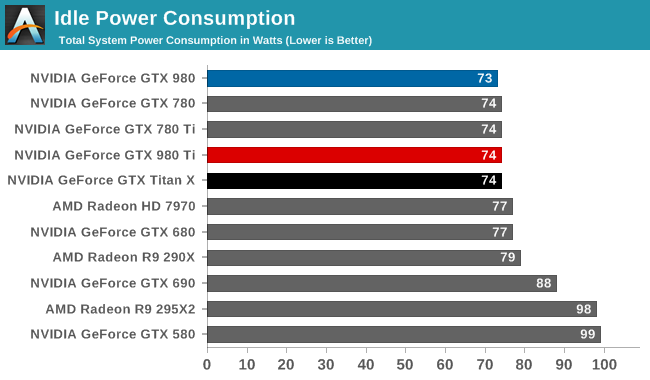
Starting off with idle power consumption, there's nothing new to report here. GTX 980 Ti performs just like the GTX Titan X, which at 74W is second only to the GTX 980 by a single watt.
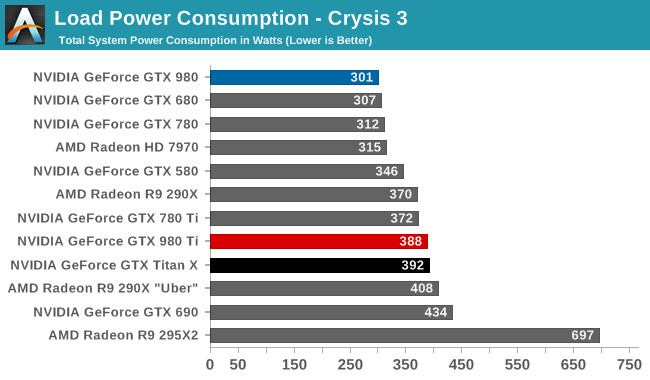
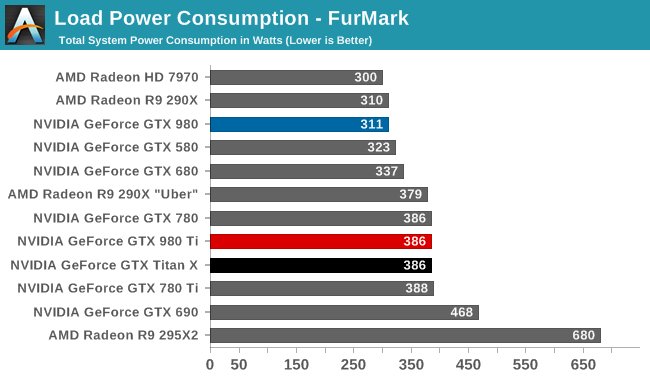
Meanwhile load power consumption is also practically identical to the GTX Titan X. With the same GPU on the same board operating at the same TDP, GTX 980 Ti ends up right where we expect it, next to GTX Titan X. GTX Titan X did very well as far as energy efficiency is concerned – setting a new bar for 250W cards – and GTX 980 Ti in turn does just as well.
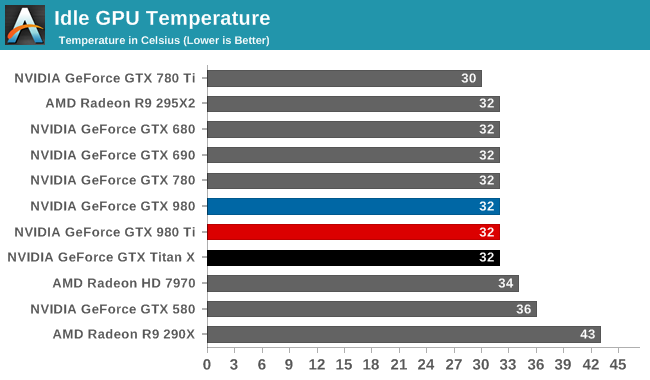
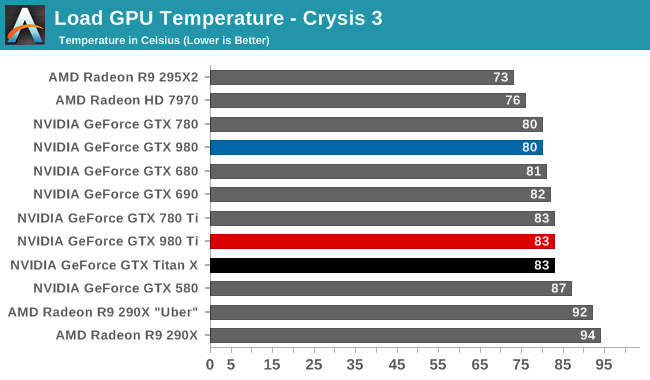
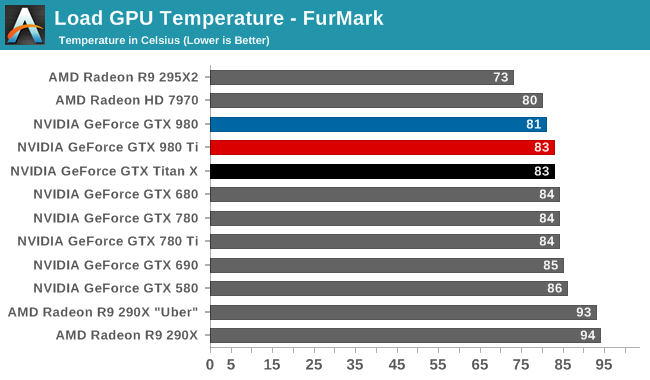
As was the case with power consumption, video card temperatures are similarly unchanged. NVIDIA’s metal cooler does a great job here, keeping temperatures low at idle while NVIDIA’s GPU Boost mechanism keeps temperatures from exceeding 83C under full load.
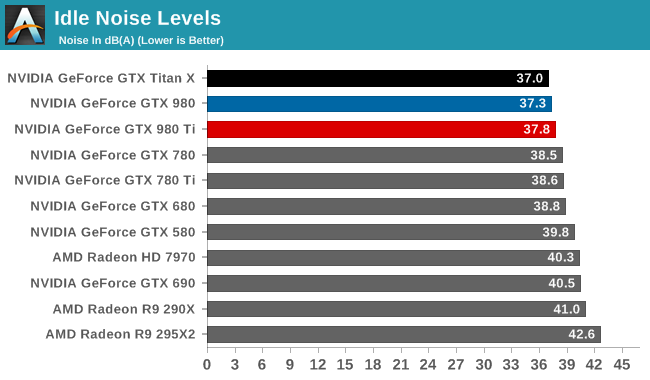
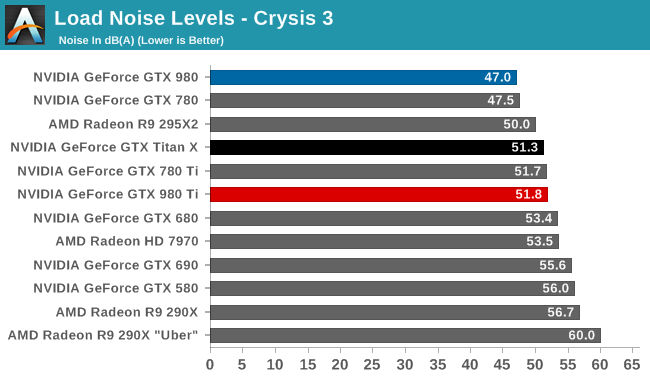
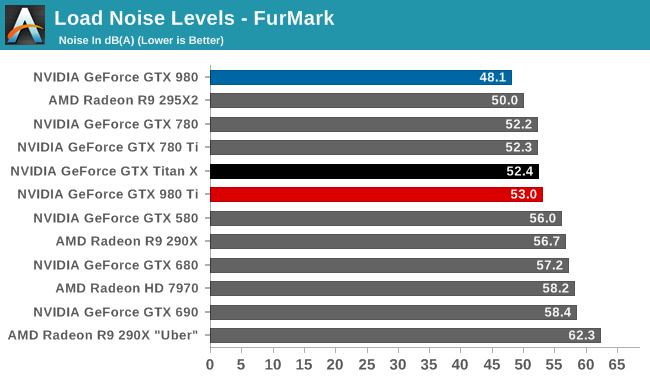
Finally for noise, the situation is much the same. Unexpected but not all that surprising, the GTX 980 Ti ends up doing a hair worse than the GTX Titan X here. NVIDIA has not changed the fan curves or TDP, so this ultimately comes down to manufacturing variability in NVIDIA’s metal cooler, with our GTX 980 Ti faring ever so slightly worse than the Titan. Which is to say that it's still right at the sweet spot for noise versus power consumption, dissipating 250W at no more than 53dB, and once again proving the mettle of NVIDIA's metal cooler.










290 Comments
View All Comments
jjj - Sunday, May 31, 2015 - link
lol they got way high margins on the big cards ,they could sell this easily at 500$ (where perf per price would be close to the 970) and have good margins, if AMD has the big enough card, all they need is to want to be price competitive.These are not products for people that look for reasonable value, nobody that looks for that would ever pay 500$ for a GPU to begin with so both AMD and Nvidia are just keeping the high margins since volumes can't really go up.
Yojimbo - Sunday, May 31, 2015 - link
I don't know how you can say the value is unreasonable when there is no other way to achieve what these cards achieve. The high end of the graphics market is less sensitive to price than more mainstream segments. Both AMD and NVIDIA are trying to maximize their profits over the entire market range.jjj - Sunday, May 31, 2015 - link
You seem to not understand the term value and then you explain why the high end cards are poor value.Value and competitiveness are 2 different things. One is perf per price and the other is how the product relates to it's competitors. Yes the high end is less price sensitive (something my first comment agreed with) and the cards are poor value that's why i found it amusing that someone thinks the perf per price is great, when it never is in the category.
Daroller - Monday, June 1, 2015 - link
"You do not seem to don't understand the term value, and then you explain why the high end cards are poor value."Oh, that's rich.
Value in this case is a subjective term. Each consumer defines the value of a product to them. It isn't something you can put on a chart, or quantify, unless that's how they choose to define it for themselves.
I own two TITAN X in SLI to drive a 1440p display. You'd probably call that "poor value". You'd be correct... for yourself. You'd be woefully incorrect if we're discussing what I consider "value", because I considered the price/performance ratio to be perfectly acceptable, and moreover, a "good deal" to eliminate all possibility of VRAM related stuttering. All this while giving me the same number of shader cores as a tri-SLI 980 setup with better scaling because it's only two cards. A resounding value in my books.
Refuge - Monday, June 1, 2015 - link
lol, you lost all credibility with anyone here after you said you were using Titan X's in SLI because you are worried about running out of VRAM and stuttering...I wouldn't call that poor value, I would just call that retarded.
Yojimbo - Monday, June 1, 2015 - link
And yet despite his lack of "credibility" everything he said was completely correct. What does that say about your ability to judge?Kutark - Monday, June 1, 2015 - link
This whole thread could have been fixed if the guy said "objectively" instead of just "value".Yes, what constitutes a good value varies from person to person. Anyone with a brain can infer what he was trying to say in his argument, which is absolutely correct, is that at this price bracket, people aren't buying cards based on price/perf. So, whether or not the price/perf is comparable to lower cards is irrelevant. They price according to what the market will be bear. If they're selling them as fast as they can make them, then they're selling them at the right price.
Yojimbo - Tuesday, June 2, 2015 - link
No. Especially since he replied back to me and ridiculed me for not knowing what "value" is. That by itself is enough of a refutation of your "just try to guess what he meant" argument. But if he really did mean what you think he did, his post is irrelevant, because value is the proper metric, and it is not "objective". That really is the entire point, and why something needed to be said.Yojimbo - Tuesday, June 2, 2015 - link
And one more thing. The fact that they aren't buying the cards to maximize "price/perf" is blatantly obvious, and just as blatantly irrelevant. The problem I'm having is, and I could be wrong here, that you and he both seem to be convinced they SHOULD be buying the cards on "price/perf."mapesdhs - Wednesday, June 3, 2015 - link
I'd buy you a beer for posting that if I could. 8) It's the perfect summation of what I've said so often, namely an item is only ever worth what someone is willing to pay. It's funny how people can get so offended that someone else can afford and is happy to buy a far better config than they do; really it's just hidden jealousy IMO. Either way, kudos for that rig, and please post some 3DMark bench links! 8) Actually, you should buy the beer, you can afford it, hehe...I wonder if you have a similar MO to me, I like to max out visual settings for the games I play, modding if need be to improve visuals. I hate scenery popping, etc.